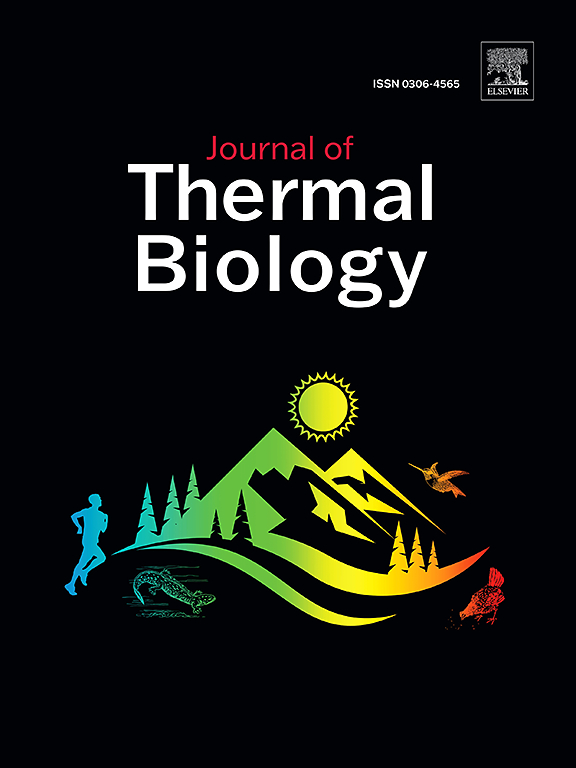探讨地源热泵和精密送风系统在奶牛舍热应激缓解中的应用潜力。
IF 2.9
2区 生物学
Q2 BIOLOGY
引用次数: 0
摘要
在集约化养殖场,保持最佳的室内热环境对提高牲畜的福利和生产力至关重要。本文研究了地热热泵与精密送风系统(GHP-PAS)在某奶牛场奶牛降温中的应用。评价了GHP-PAS系统在缓解泌乳奶牛热应激方面的有效性,以及其能量性能和自由栏局部冷却效率。试验选用140头产乳荷斯坦奶牛,分为两组。一组饲养在装有GHP-PAS系统的仓房(GP仓房,n = 70),另一组饲养在装有常规风机喷水系统的仓房(FS仓房,n = 70)。结果表明:GP和FS仓内环境温度均低于仓外温度(p0.05)。与FS牲口棚的奶牛相比,GP牲口棚的奶牛表现出较低的皮肤温度、直肠温度和呼吸频率(P本文章由计算机程序翻译,如有差异,请以英文原文为准。
Investigating the potential of geothermal heat pump and precision air supply system for heat stress abatement in dairy cattle barns
Maintaining an optimal indoor thermal environment is crucial for enhancing the welfare and productivity of livestock in intensive breeding farms. This paper investigated the application of a combined geothermal heat pump with a precision air supply (GHP-PAS) system for cooling dairy cows on a dairy farm. The effectiveness of the GHP-PAS system in mitigating heat stress in lactating dairy cattle, along with its energy performance and local cooling efficiency in the free stalls were evaluated. A total of 140 multiparous lactating Holstein cows was tested in two groups. One group was housed in a barn equipped with a GHP-PAS system (GP barn, n = 70), and the other was housed in a barn with a conventional fan-sprinkling system (FS barn, n = 70). Results showed that the ambient temperature of both GP and FS barns were lower than that outside the barn (P < 0.05), with no significant difference between the GP and FS barns (P > 0.05). Compared to cows in the FS barn, those in the GP barn exhibited lower skin temperature, rectal temperature, and respiratory rate (P < 0.05). The mean temperature difference between outflow and inflow water was 2.56 °C of the GHP unit. The average energy efficiency ratios (EER) of the GHP unit and the GHP-PAS system were 5.03 and 2.92, respectively. The daily average electricity consumption was 20.4 ± 1.0 kWh. The field test results indicated that the airflow from a single nozzle of the GHP-PAS system effectively covered a stall space with an average width of 1.84 m at a cow reclining height of 0.5 m, with an average air velocity of 1 m/s. The per-cow hourly electricity consumption for cooling was 2.04 kWh for the GHP-PAS system and 0.36 kWh for the FS system, highlighting that the GHP-PAS system is approximately 5.6 times more energy-intensive than the FS system. In conclusion, the GHP-PAS system showed the potential for alleviating heat stress in dairy cows. Further research is needed to enhance the energy efficiency and cooling effectiveness of the current GHP-PAS system.
求助全文
通过发布文献求助,成功后即可免费获取论文全文。
去求助
来源期刊

Journal of thermal biology
生物-动物学
CiteScore
5.30
自引率
7.40%
发文量
196
审稿时长
14.5 weeks
期刊介绍:
The Journal of Thermal Biology publishes articles that advance our knowledge on the ways and mechanisms through which temperature affects man and animals. This includes studies of their responses to these effects and on the ecological consequences. Directly relevant to this theme are:
• The mechanisms of thermal limitation, heat and cold injury, and the resistance of organisms to extremes of temperature
• The mechanisms involved in acclimation, acclimatization and evolutionary adaptation to temperature
• Mechanisms underlying the patterns of hibernation, torpor, dormancy, aestivation and diapause
• Effects of temperature on reproduction and development, growth, ageing and life-span
• Studies on modelling heat transfer between organisms and their environment
• The contributions of temperature to effects of climate change on animal species and man
• Studies of conservation biology and physiology related to temperature
• Behavioural and physiological regulation of body temperature including its pathophysiology and fever
• Medical applications of hypo- and hyperthermia
Article types:
• Original articles
• Review articles
 求助内容:
求助内容: 应助结果提醒方式:
应助结果提醒方式:


